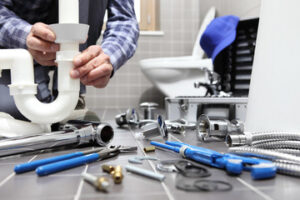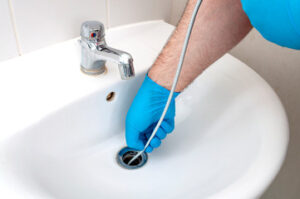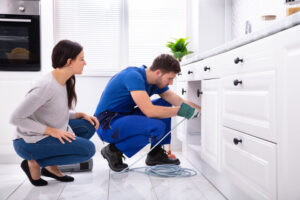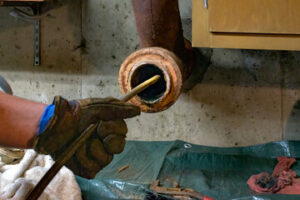Plumbing involves distributing potable water and removing waste from residential, commercial, and industrial facilities. It also deals with the installation and repair of appliances and fixtures.

A plumbing plan is a set of drawings that illustrates the system that will bring water in and take waste out. It typically includes a water supply line, drain lines, and vents. Checkout https://freedomplumbingnj.com/ for more information.
The plumbing system in a house or building is composed of pipes that supply water for drinking and bathing, and remove waste and sewage. It is important for the health and safety of occupants, and proper functioning requires regular maintenance and repairs. If your plumbing is not working properly, it can cause serious health problems and damage property. In addition, it can also affect the environment. Fortunately, the right plumber can fix these issues quickly and efficiently.
The primary function of a plumbing system is to provide potable water to household appliances and fixtures. It also protects against fire by delivering water to fire sprinkler systems. In addition, it keeps the water pressure in a house at an acceptable level. The pressure of water depends on its temperature and the friction caused by moving it through pipes. Therefore, a plumber must understand the principles of hydraulics to design and build a reliable plumbing system.
A plumbing system also contains a series of drains that collect and transport waste water away from sinks, tubs, and toilets. It may also include a sewer system, which carries sewage away from the home. A sewer system typically connects to the municipal water supply and is regulated by local authorities. A plumber can install, repair, and maintain these systems.
There are several different types of plumbing systems, including residential, commercial, and industrial. Each type has its own unique set of functions. A residential plumbing system usually consists of a hot and cold water supply line, a drainage system, and a water meter. It also includes a set of valves and faucets for use in kitchens, bathrooms, and other rooms. A commercial or industrial plumbing system has a more complex design, and it can include many more components.
The plumbing industry is regulated at the federal, state, and local levels. Plumbers must be licensed by their respective government to perform plumbing work. The licensing process varies by country, but it generally involves an exam and experience requirements. Some jurisdictions even require certification for master plumbers. A plumbing license can help you avoid costly mistakes and ensure that your plumbing system is safe and efficient.
Materials
There is a wide variety of plumbing materials that can be used in home and commercial plumbing systems. The choice of which type of piping material to use depends on the specific circumstances and requirements of the project at hand. Some of the most popular options are copper, CPVC, PVC, and PEX pipes. Each has its own benefits and drawbacks, so it is important to understand these before making a final decision.
Copper pipes are durable and can withstand high water pressures. They also have low thermal conductivity, which helps reduce energy costs. They are also resistant to corrosion and do not rust. However, copper is expensive and requires specialist tools for installation. Additionally, it can corrode when exposed to acidic water. CPVC pipes are another good option for domestic plumbing, as they are durable and able to withstand high water temperatures. They are also safe for drinking water and do not corrode. However, CPVC is not as flexible as copper and can crack if it is subjected to excessive stress.
Polyvinyl chloride (PVC) pipes are inexpensive and easy to install. They are also resistant to corrosion and high water pressures, and can be adapted for underground drain pipes. They are also safer than metal pipes for potable water and can be insulated to reduce energy costs. However, they can be damaged by hot water and must be protected from UV rays.
Acrylonitrile butadiene styrene (ABS) pipes are similar to PVC, but they are more affordable and resilient to cold temperatures. They are typically found in sewer and vent pipes, as well as electrical insulation. They are also easier to install than metallic or PVC pipes, as they do not require glue and are lightweight. However, they are not suitable for use in groundwater applications.
The most common plumbing materials are copper, CPVC, PVC, PEX, and galvanized steel. Each has its own advantages and disadvantages, but it is best to choose a material that is suited to the local environment. For example, galvanized steel pipes were once a popular choice for household plumbing, but they have many disadvantages. These include rusting and corrosion, which can be damaging to the health of people who drink the water. In addition, they are a heavy material that limits their uses in plumbing systems, such as drains for greywater and non-potable water.
Regulations
Before beginning work on a plumbing project, it is important to understand the regulations that govern such projects. These laws are developed by state and local authorities and set minimum standards for the design, installation, and inspection of plumbing systems. The regulations ensure that plumbing installations protect the health and safety of building occupants. They also safeguard the public from exposure to dangerous substances and contaminants.
The regulations set the standards and requirements for piping systems, fixtures, devices, and equipment used in plumbing installations. They are created by professional associations and published in a code that is updated on a three-year cycle. The 2024 edition of the National Standard Plumbing Code-Illustrated includes revisions that promote sustainable plumbing practices. In addition, it includes a new appendix addressing plumbing requirements for indoor horticultural facilities.
All plumbing projects must comply with these rules and regulations. They must also be inspected by the plumbing inspector before being used for their intended purpose. The inspector has the authority to enter any building or premises to inspect the plumbing and drainage systems. He can also remove or insect any plumbing work that is not in compliance with the code.
The sanitary codes were created to prevent contamination of drinking water and sewage pipes. They were developed not long after the Civil War by professional societies of plumbers and sanitary engineers. These societies were concerned about the lack of hygienic conditions that existed in many urban areas and started writing down basic sanitary concepts. The code is based on the principles of water conservation, safe sanitary conditions, and the prevention of contamination.
Any person who carries out plumbing, septic or drainage work must be licensed by the local county. The license must be renewed every two years. The licensee must also attend continuing education courses to keep up with current technology and techniques in the industry. In addition, the licensee must pay annual licensing fees.
The City of Auburn requires that all plumbing work be done by a licensed, professional plumber. Any work that is not completed in accordance with the city code will be subject to fines and penalties. The code includes basic plumbing principles such as:
Certifications
Plumbing is a skilled trade that requires significant training and certifications. Most states have apprenticeship requirements that require a specific number of hours working with journeymen or master plumbers to learn how to install fixtures and pipes, read blueprints, understand state and local plumbing codes, and perform various job-related tasks. On-the-job training also includes Occupational Safety and Health Administration (OSHA) and other workplace safety regulations, soldering and using power tools, and responding to inspectors and handling clients.
A career as a plumber can be highly rewarding. In addition to learning a valuable trade, many plumbers advance into management positions in large plumbing companies or own their own businesses. While the upfront costs of becoming a plumber can be high, there are opportunities to reduce these expenses with scholarships and grants. For example, the Associated Builders and Contractors Empire State Chapter offers a free four-year plumbing apprentice program at its Construction Training Centers in Albany and Long Island. Some community colleges also offer free and affordable classes for adult learners.
After completing an apprenticeship and passing a licensing exam, you can begin work as a plumbing journeyperson. Many states require licensed plumbers to complete continuing education programs every three years. These courses keep you up-to-date on new plumbing code changes and help you to maintain your license.
In addition to standard plumbing jobs, some plumbers specialize in medical gas systems and fire protection. Specialty plumbers can use their skills to improve the environmental impact of a home or commercial building by installing green plumbing solutions that lower energy bills and increase efficiency.
Besides the necessary training, plumbers must obtain a business license and carry workers’ compensation insurance, general liability insurance and unemployment insurance. Some cities and counties may also require a bond prior to plumbing licensure.


